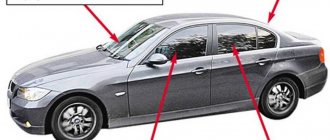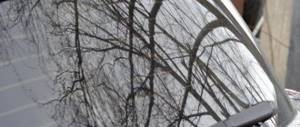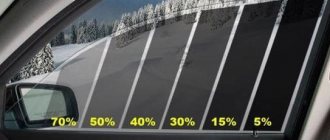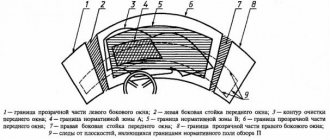What is tinting 70%
The parameter 70 percent means light transmittance. That is, the glass after applying the film will transmit at least 70% of light rays. This level of light transmission allows the use of tinting, including on the windshield.
According to current technical regulations and GOSTs, the windshield must transmit at least 70% of light. This means that such a film can be used without restrictions, even just sticking it on the windshield, or even tinting the entire car in a circle.
Please note that the degree of light transmittance on the glass of the front doors is not regulated from 2021. Accordingly, the inspector’s attempts to measure the transparency of the side glass are unlawful. Although such attempts occur, traffic police officers sometimes take advantage of drivers’ ignorance of the new rules
In practice, tinting with a density of 70% is almost transparent. It looks like slightly darkened glass. Therefore, when completely tinting a car, there is no point in using such material. It is usually used for windshields.
The material is often used for ultraviolet protection. Almost all tint films are capable of blocking up to 99% of ultraviolet rays. Therefore, if you do not want to make your car completely tinted, you can use a film with a light transmittance of 70 percent; on the one hand, this will not cause you discomfort, on the other hand, you will receive reliable protection from harmful rays.
Features of use.
The car is used by sales representatives; in the summer, work tablets, constantly lying in the cabin, overheated and often failed. As a result, on the advice of a car mechanic, the car was tinted with athermal film with a transparency of 70%. The problem with the hot interior went away immediately.
What is the percentage of car window tinting?
- 75%
Complies with state standards for front glass and side windows. You can see what 75 percent tinting looks like in examples of completed work. This darkening gives a slight rainbow effect. The ideal option is to use an athermal coating that will look aesthetically pleasing on any vehicle.
- 70%
The value corresponds to the standard for front side windows. It is considered a borderline option, allowing you to achieve a beautiful shaded effect. Creates a cozy atmosphere in the cabin and perfectly protects from bright sunlight.
- 50%
Used for rear windows. Allows you to create a comfortable atmosphere. Although the percentage of darkening the tint is quite high, the interior remains visible. Dimmed lighting protects the eyes from UV radiation and protects interior items from overheating and fading.
- 35%
Option for rear hemispheres. Allows you to create a private environment. Passengers are quite difficult to see. Only silhouettes will be visible. A car with such darkening looks solid and elegant.
- 20%
Used to create privacy and maximum comfort for rear passengers. The driver must be very careful and be sure to use rear-view mirrors.
- 15%
This tint light transmittance creates an almost complete privacy atmosphere in the rear of the car. In poor visibility and in the evening/night time, the driver must be extremely careful and always use the side mirrors.
- 5%
This percentage of shading is chosen when they want to create complete privacy. Can only be used at the rear. Tinted glass provides maximum protection from the sun and prying eyes.
Varieties
When choosing a tint, you should take into account the characteristics of different types of this material. Let's look at the most common film options that you can buy.
- Removable film. Allows you to quickly tint your car and remove the darkening at the same speed. Typically used as a temporary solution. The main disadvantages include the insufficiently neat appearance.
- Painted tinting. This film has a layer of dye, which gives the darkening effect. Such materials sometimes do not meet the specified specifications, which can lead to a fine for violating glass tinting standards. On the other hand, this is a very cheap solution, although short-lived.
- Metallized film. This is a three-layer tint. A metal coating is placed between two polymer layers. The result is a virtually non-fading, non-damaging darkening. This film lasts quite a long time.
- Sputter. Metal spraying is also used here, but the technical solution to this problem is different. There is only one polymer layer, and the sputtering is introduced into the film under certain conditions. This provides good protection against damage, and also provides a number of additional advantages, in particular, the film blocks ultraviolet rays well.
- Carbon. The rarest and most expensive tinting option. Graphite coating is used here, which gives the film a matte appearance. Manufacturers claim that the tinting will last almost forever. Due to the high cost, this is rare among us.
- Athermal film. Designed primarily to protect the interior from overheating. Special components prevent the sun's rays from warming up the interior. Allows you to achieve comfortable conditions in the car, even if you are forced to leave it in the sun.
The choice of a specific variety depends primarily on financial capabilities. You also need to take into account the operating features, as well as the individual preferences of the car owner.
Requirements for auto glass according to traffic regulations and GOST
Not a single regulatory document of the Russian Federation puts forward a complete ban on covering auto glass with darkening films. Only coatings that do not meet established light transmittance standards are prohibited.
According to the rules established by Section 7 of the Traffic Regulations of the Russian Federation, namely clause 3, it is prohibited to apply coatings to glass that limit the driver’s visibility. The only exceptions are tinting films, which fully comply with GOST 32565-2013, which came into force in 2015.
Light transmission standards
This standard puts forward the following requirements for auto glass:
- Light transmittance of windshield and side windows from 70%.
- The degree of shading of the rear windows can be any, provided that there are external rear-view mirrors on both sides.
- The use of mirror film is not allowed.
- The width of the protective transparent light strip located on the top of the windshield should not exceed 14 cm.
- It is not allowed to cover glass with multi-colored films.
But, despite the existence of the standard, many car owners continue to drive with almost zero-tinted windows, which impairs the driver’s visibility and increases the risk of collision with other road users.
Which film is prohibited
Not all tinting is equally useful; there are options that cannot be used without the risk of getting a fine. Even taking into account the fact that technically, darkening car windows with 70% transparency can be used without restrictions. Let's see what tint is not recommended for cars.
- Films with mirror effect. Such a solution is completely prohibited. Tinting reflects light and can blind other road users. The most common metallized film coated with aluminum is worth buying such material only if you are willing to periodically pay fines.
- Green and blue tint. The restriction applies only to these colors; other color films can be freely used.
- Chameleon. Another type of tinting that causes rejection among legislators. According to experts, such a film, changing color depending on the viewing angle, can reflect light rays. In fact, the effect of changing the color of the film is based on this principle. This makes it possible to equate the material to the mirror type.
By choosing any of the listed types of tinting, you increase the risk of a fine. The fact is that such a darkening is very noticeable and will certainly attract the attention of a traffic police officer.
Example from practice.
While working along the highway, the inspector noticed that one car was tinted with a chameleon film. All glass was finished with this material. At the same time, everything was visually transparent. Despite the protests of the driver, who claimed that the light transmittance of the glass was 70%, a protocol was issued. As evidence, a photo of a car with the appropriate tint was taken. The fine of 1,000 rubles could not be appealed.
Types of tinted films
To make it easier to choose a film for tinting, you need to understand the properties of the film substance itself. Modern manufacturers make them from both expensive and cheap materials.
They are usually divided into the following groups:
- inexpensive budget option (substance in the form of paint for coating);
- metallized type, more reliable glass protection;
- spatter;
- mirror type;
- athermal;
- gradient type;
- removable;
- carbon.
Which of these types of tinted films should you choose for your car? We advise you to choose the one that is comfortable for you. If you need tinting 70, then the choice will be huge. You can use any type of film for this. Since tinting 70 is considered the most popular percentage in the world, manufacturers make different types of such products.
It is worth noting that this percentage of tinting is quite dark compared to others, and when choosing it, you should remember that it is prohibited to use such a percentage for the windshield. But in some countries it is allowed to stick a dark film on the side front windows, although not everyone resorts to this. Interestingly, the 70 percent tint itself looks attractive both outside and inside the car.
How to choose the right one
The correct selection determines how well and reliably the car will be covered. Let's look at the main stages of selection.
- We decide what type of film we need. Here you need to take into account both cost and technical characteristics. You should not take a very cheap film, it will most likely not be of good enough quality. We select the type of tinting based on personal preferences.
- Let's look at the manufacturer. The best solution would be to purchase tint from American manufacturers. Although such material will hit your pocket hard. You shouldn’t be afraid of Chinese products, you just need to pay attention to well-known manufacturers and not take the cheapest film.
- Determine the required volume. Often, tint is sold in whole rolls. You don’t need so much, it’s better to look for an alternative option where you can buy as much as you need. Always take with a small margin, especially if this is your first time tinting the car yourself.
These are the points to consider when choosing and purchasing film. Pay special attention to the manufacturer; high-quality tinting will last longer.
Visor
The most popular and generally accepted way to tint glass with a 70% tinted film is to make a strip at the top of the car window. This stripe is found on 50% of cars on our roads. It is designed to protect the driver's eyes from the sun while driving. This kind of visor should be no more than 20 cm wide. The most popular type of tinting is athermal, which is most often used for making visors.
The good thing is that you can apply 70% tint yourself; a special self-adhesive film is sold for this. It is very easy to use. Typically, drivers apply this film quickly and without problems.
Useful tips
Below we will tell you some points that are important to know for a car enthusiast who decides to tint a car on his own.
- If this is your first time working with tint, take more film. One piece will be useful for training. Try sticking the training film onto the glass first. Pay attention to how you do it, what shortcomings will be identified during the work. This will greatly simplify working directly on the machine.
- When tinting the front and rear doors, it is not necessary to disassemble the door panel. You can stick the film without unnecessary movements, but this will require care and attention.
- If the glass has chips and cracks, there is a risk that they will crack when heated with a hairdryer. It is better to abandon the idea of tinting.
- Only careful surface preparation will avoid problems. Pay special attention to removing dirt and dust. Even a small speck of dust can ruin the appearance of tinted glass.
- Be sure to let the tint dry. During the drying time, try not to interact with the glass, and also do not use the door lifts.
What fine can you get in the Russian Federation for violating tinting standards in 2021?
If a traffic police officer stopped you for the first time, you will have to pay 500 RUB. In case of repeated violation, administrative arrest is possible for up to 15 days.
If, after the second offense, the driver does not take into account the permitted percentage of tinting in Russia within a calendar year from the date of payment of the fine, he will be fined again, but for a larger amount, or deprived of his license for 1-3 months. In this case, the verdict is made by the court.
A State Traffic Inspectorate employee will not be able to determine by eye what percentage the tinting of your car is. For this purpose, equipment is used - a taumeter. The procedure is carried out in a specially designated point.
In order not to violate, choose a film with permitted light transmittance, take into account GOST.
Legal ways to tint
Any darkening that meets light transmittance standards is permitted by law. So, recently polymer tinting has been recognized as permitted. Now it doesn’t matter whether the film was installed or the windows were tinted using a special spray. Drivers are worried about how to get permission to tint their front windows.
Darkening car windows using spraying is not in demand among car owners. High-quality work is difficult to find, and low-quality material quickly becomes unusable. The applied layer of metal on the glass is mirrored and looks similar to factory tinting.
Electrochromic tinting is a new trend on the Russian market, allowing you to change the level of light transmittance at the driver’s request. The cost of the device can reach 80 thousand rubles. The device has one more drawback - it is also hard to see in the cabin.
The use of curtains on rear windows is not prohibited. The car owner can tint the windows with special car nets. This is a good alternative to tinting. The nets can be installed or removed whenever desired, since the structure is removable. Clips made of plastic are mounted in the glass seal. This method is a definite advantage, because you do not need to dismantle the door trim or use glue. An easy installation procedure will save you money. It’s easy to install the curtain yourself, without going to a car service.
Whether it is worth tinting the front windows is up to the driver to decide. Very dark or mirrored car windows are a possible cause of accidents. The driver must be aware of what is more important: safety or comfort.











